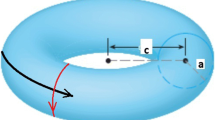Abstract
We have studied the dynamics and symmetries of a particle constrained to move in a torus knot. The Hamiltonian system turns out to be Second Class in Dirac’s formulation and the Dirac brackets yield novel noncommutative structures. The equations of motion are obtained for a path in general where the knot is present in the particle orbit but it is not restricted to a particular torus. We also study the motion when it is restricted to a specific torus. The rotational symmetries are studied as well. We have also considered the behavior of small fluctuations of the particle motion about a fixed torus knot.
Similar content being viewed by others
References
Snyder, H.S.: Quantized space-time. Phys. Rev. 71, 38 (1947)
Kempf, A., Mangano, G., Mann, R.B.: Hilbert space representation of the minimal length uncertainty relation. Phys.Rev. D52 1108–1118 (1995). arXiv:math/9412167
Seiberg, N., Witten, E.: String theory and noncommutative geometry. JHEP 9909, 032 (1999)
Amelino-Camelia, G.: Relativity: special treatment. Nature 418, 34–35 (2002)
Amelino-Camelia, G.: Testable scenario for relativity with minimum-length. Phys. Lett. B 510, 255–263 (2001)
Banerjee, R., Kulkarni, S., Samanta, S.: Deformed symmetry in snyder space and relativistic particle dynamics. JHEP 0605, 077 (2006). arXiv:hep-th/0602151
Ghosh, S., Pal, P.: Deformed Special Relativity and Deformed Symmetries in a Canonical Framework. Phys. Rev. D 75, 105021 (2007). arXiv:hep-th/0702159
Das, S., Vagenas, E.C.: Universality of quantum gravity corrections. Phys. Rev. Lett. 101, 221301 (2008). arXiv:0810.5333
Brau, F.: Minimal length uncertainty relation and hydrogen atom. J. Phys. A 32, 7691–7696 (1999). arXiv:quant-ph/9905033
Scardigli, F., Casadio, R.: Generalized uncertainty principle, extra-dimensions and holography. Class. Quant. Grav. 20, 3915–3926 (2003). arXiv:hep-th/0307174
Ghosh, S., Mignemi, S.: Quantum mechanics in de Sitter space. Int. J. Theor. Phys. 50 1803–1808 (2011). arXiv:0911.5695
Quesne, C., Tkachuk, V. M.: Lorentz-covariant deformed algebra with minimal length and application to the 1+1-dimensional Dirac oscillator. J. Phys. A 39 10909–10922 (2006). arXiv:quant-ph/0604118
Chang, L.N., Minic, D., Okamura, N., Takeuchi, T.: Exact solution of the harmonic oscillator in arbitrary dimensions with minimal length uncertainty relations. Phys. Rev. D 65, 125027 (2002). arXiv:hep-th/0111181
Pramanik, S., Ghosh, S.: GUP-based and snyder non-commutative algebras, relativistic particle models and deformed symmetries: a unified approach. Int. J. Mod. Phys. A 28, 1350131 (2013). arXiv:1301.4042
Pramanik, S., Ghosh, S., Pal, P.: Electrodynamics of a generalized charged particle in doubly special relativity framework. Ann. Phys. 346 113 (2014). arXiv:1212.6881
Douglas, M.R., Nekrasov, N.A.: Noncommutative field theory. Rev. Mod. Phys. 73, 977–1029 (2001)
Szabo, R.J.: Quantum field theory on noncommutative spaces. Phys. Rept. 378, 207–299 (2003)
Banerjee, R., Chakraborty, B., Ghosh, S., Mukherjee, P., Samanta, S.: Topics in noncommutative geometry inspired physics. Found. Phys. 39, 1297–1345 (2009)
Sreedhar, V. V.: The classical and quantum mechanics of a particle on a knot. Ann. Phys. doi:10.1016/j.aop.2015.04.004. arXiv:1501.01098 [quant-ph]
Ohnuki, Y., Kitakado, S.: On quantum mechanics on a compact space. Mod. Phys. Lett. A 7, 2477 (1992)
Coleman, S.: Aspects of Symmetry. Cambridge University Press, Cambridge (1988)
Wilczek, F.: Fractional Statistics and Anyon Superconductivity. World Scientific Publishing Company Pvt, Ltd, Singapore (1990)
Gorsky, A., Milekhin, A.: Condensates and instanton—torus knot duality. Hidden Phys. UV Scale. arXiv:1412.8455
Nejad, S. A., Dehghani, M., Monemzadeh, M.: Lagrange multiplier and Wess-Zumino variable as large extra dimensions in the torus universe. arXiv:1508.01866
Floreanini, R., Peracci, R., Sezgin, E.: Quantum mechanics on the circle and W(1+infinity). Phys. Lett. B 271, 372–376 (1991)
Dirac, P.A.M.: Lectures on Quantum Mechanics. Yeshiva University Press, New York (1964)
Nguyen, S., Turski, L.A.: Examples of the Dirac approach to dynamics of systems with constraints. Physica A 290, 431–444 (2001)
Morse, P.M., Feshbach, H.: Methods of Theoretical Physics. McGraw Hill, New York (1953)
Acknowledgments
P. D. acknowledges the financial support from INSPIRE, DST, India.
Author information
Authors and Affiliations
Corresponding author
Appendices
Appendix 1
In the terminology of Dirac constraint analysis [26], the noncommutating constraints are termed as SCC and the commutating constraints, that induces local gauge invariance, are named First Class Constraints (FCC). In a generic Second Class system with n SCCs \(\chi _i\), \(i=1,2,..n\), the modified symplectic structure (or Dirac brackets) are defined in the following way,
where \(\{\chi ^i,\chi ^j\}\) is the invertible constraint matrix. From now on we will use \(\{,\}\) notation instead of \(\{,\}^*\) for Dirac brackets.
In Cartesian coordinate system, the non-zero constraints matrix element reads
where, \(A_i=\frac{\partial \psi _1}{\partial x_i},~A^2=\frac{4a^2}{\phi }+\frac{\alpha ^2}{r^2-x_3^2}.\) Thus the inverse matrix element can be written as,
The Dirac bracket can be computed in the following way,
Appendix 2
In toroidal coordinate system, the non-zero constraints matrix element is
Thus the inverse matrix element can be written as
The Dirac bracket
can be computed in the following way,
where \(\alpha =-\frac{q}{p}\).
Appendix 3
We provide some useful identities connecting the toroidal coordinate system to Cartesian coordinate system. The unit vectors are related as,
The conjugate momenta are related as,
Rights and permissions
About this article
Cite this article
Das, P., Ghosh, S. Particle on a Torus Knot: A Hamiltonian Analysis. Found Phys 46, 1649–1665 (2016). https://doi.org/10.1007/s10701-016-0035-6
Received:
Accepted:
Published:
Issue Date:
DOI: https://doi.org/10.1007/s10701-016-0035-6



